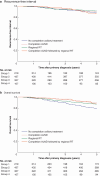De-escalation of axillary treatment in the event of a positive sentinel lymph node biopsy in cT1-2 N0 breast cancer treated with mastectomy: nationwide registry study (BOOG 2013-07)
- PMID: 38597154
- PMCID: PMC11004788
- DOI: 10.1093/bjs/znae077
De-escalation of axillary treatment in the event of a positive sentinel lymph node biopsy in cT1-2 N0 breast cancer treated with mastectomy: nationwide registry study (BOOG 2013-07)
Abstract
Background: Trials have demonstrated the safety of omitting completion axillary lymph node dissection in patients with cT1-2 N0 breast cancer operated with breast-conserving surgery who have limited metastatic burden in the sentinel lymph node. The aim of this registry study was to provide insight into the oncological safety of omitting completion axillary treatment in patients operated with mastectomy who have limited-volume sentinel lymph node metastasis.
Methods: Women diagnosed in 2013-2014 with unilateral cT1-2 N0 breast cancer treated with mastectomy, with one to three sentinel lymph node metastases (pN1mi-pN1a), were identified from the Netherlands Cancer Registry, and classified by axillary treatment: no completion axillary treatment, completion axillary lymph node dissection, regional radiotherapy, or completion axillary lymph node dissection followed by regional radiotherapy. The primary endpoint was 5-year regional recurrence rate. Secondary endpoints included recurrence-free interval and overall survival, among others.
Results: In total, 1090 patients were included (no completion axillary treatment, 219 (20.1%); completion axillary lymph node dissection, 437 (40.1%); regional radiotherapy, 327 (30.0%); completion axillary lymph node dissection and regional radiotherapy, 107 (9.8%)). Patients in the group without completion axillary treatment had more favourable tumour characteristics and were older. The overall 5-year regional recurrence rate was 1.3%, and did not differ significantly between the groups. The recurrence-free interval was also comparable among groups. The group of patients who did not undergo completion axillary treatment had statistically significantly worse 5-year overall survival, owing to a higher percentage of non-cancer deaths.
Conclusion: In this registry study of patients with cT1-2 N0 breast cancer treated with mastectomy, with low-volume sentinel lymph node metastasis, the 5-year regional recurrence rate was low and comparable between patients with and without completion axillary treatment.
© The Author(s) 2024. Published by Oxford University Press on behalf of BJS Foundation Ltd.
Figures
References
-
- Krag DN, Anderson SJ, Julian TB, Brown AM, Harlow SP, Ashikaga T et al. Technical outcomes of sentinel-lymph-node resection and conventional axillary-lymph-node dissection in patients with clinically node-negative breast cancer: results from the NSABP B-32 randomised phase III trial. Lancet Oncol 2007;8:881–888 - PubMed
-
- Krag DN, Anderson SJ, Julian TB, Brown AM, Harlow SP, Costantino JP et al. Sentinel-lymph-node resection compared with conventional axillary-lymph-node dissection in clinically node-negative patients with breast cancer: overall survival findings from the NSABP B-32 randomised phase 3 trial. Lancet Oncol 2010;11:927–933 - PMC - PubMed
-
- Veronesi U, Viale G, Paganelli G, Zurrida S, Luini A, Galimberti V et al. Sentinel lymph node biopsy in breast cancer: ten-year results of a randomized controlled study. Ann Surg 2010;251:595–600 - PubMed
-
- Galimberti V, Cole BF, Viale G, Veronesi P, Vicini E, Intra M et al. Axillary dissection versus no axillary dissection in patients with breast cancer and sentinel-node micrometastases (IBCSG 23-01): 10-year follow-up of a randomised, controlled phase 3 trial. Lancet Oncol 2018;19:1385–1393 - PubMed
MeSH terms
Grants and funding
LinkOut - more resources
Full Text Sources
Medical



